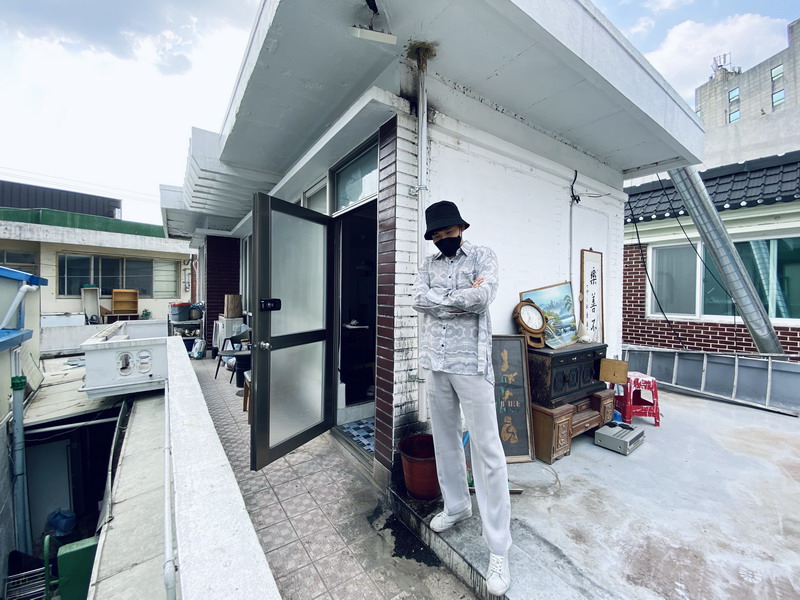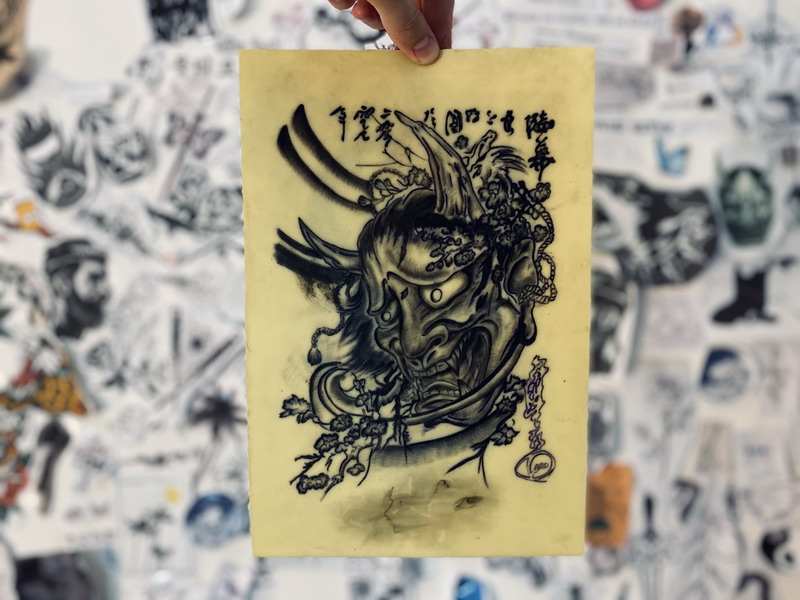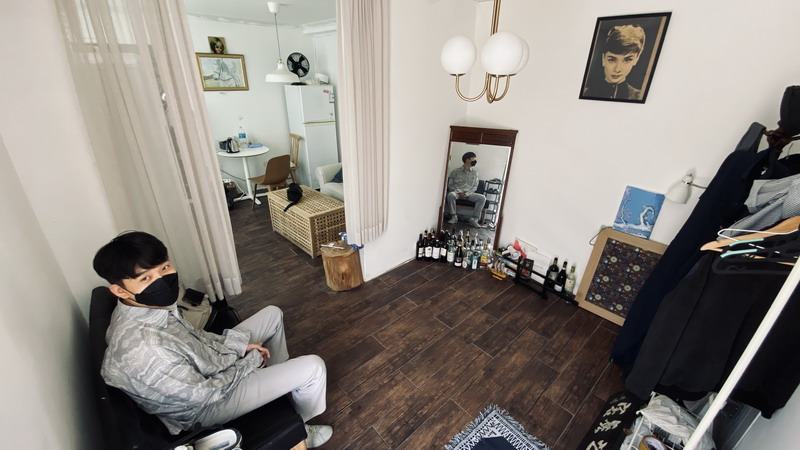Hae Um Studio: Tattooing Gwangju’s Zoomers
By Isaiah Winters.
Among my most novel experiences in Gwangju was the chance to learn the rudiments of tattooing in a cozy jutaek home-turned-tattoo studio in the Sangmu area. My instructor was young tattoo artist Kim Jinu, a fellow novelty seeker whom I’d recently met online. He first reached out to me after taking an interest in some of my odd findings, like human bones in a local graveyard, so the first time we met up, I thought I’d drive him to Songsan Amusement Park to see the sad, animal-themed paddle boats sloshing half submerged along the shoreline. Their sorry state of placid distress would be a fun way to start our photo journey, I imagined. However, I was dead wrong.

Upon glibly mentioning the park as our first destination, Jinu floored me with the sobering account of someone from his middle school who’d died there. Some idiots had thrown the poor kid’s shoes into the nearby river and, not long after wading into the shallows to retrieve them, he drowned. At that point in our conversation, it was as if all the oxygen had been sucked out of the car. I saw this as a bad omen and thought maybe I’d screwed up big, but that’s not how Jinu operates. He explores everything in conversation – the good, the bad, and the ugly – and doesn’t shy away from sensitive topics. This has made him a lot of fun to hang out with, to interview, and to learn the basics of tattooing from. What follows is our recent interview at his second-floor parlor, Hae Um Studio.
Isaiah: You know, the first thing people will likely notice is that you’ve opened a tattoo studio at a very young age. You’re only 26 in international age! What inspired you to start your own business so early on?
Jinu: I started out at Rosetattoo, another tattoo studio in Gwangju. There I met a colleague, and we learned tattooing together for seven months. Eventually, he asked, “Shall we do business together?” I had no reason to refuse, especially since I didn’t have to spend much money, seeing as he’d already invested in the business. So, I followed him, and we went into business together. He then opened another tattoo shop while I continued running his first one, which I’m now fully in charge of.
Isaiah: Wow, you were lucky to find each other. I was just going to ask whether it was hard to find a studio and register your business as a young entrepreneur. Is he also young like you?
Jinu: Yeah, he’s two years older than I am. He offered me everything for free at first, but now I’m paying him 200,000 won a month plus a separate electricity bill.

Isaiah: Not too shabby! Some friends of mine back home got their start as tattoo artists by practicing on themselves and then later on a few thrill-seeking friends. In our earlier conversations, I asked you how you made the nerve-racking leap from drawing on paper to tattooing people’s skin, and your answer fascinated me: Some artists use pigskin! I admit I became way too curious about this.
Jinu: Yes, I’m interested in why you love this pigskin detail so much. Anyway, today I’ll teach you how to tattoo a pig’s skin.
— It was at this point in the interview that Jinu produced three cuts of pigskin slightly larger than a smartphone. These he procured online before our interview for about 4,000 won each, knowing how keen I was to practice on them myself. Of course, Jinu and his peers get their practice on far more sanitary rubber pads, so this whole pigskin thing was just for my twisted pleasure. To reimburse him for the cost of each cut, I surprised Jinu with four expensive specialty beers that are hard to find in Gwangju. To begin, he showed me how to clean the cuts of skin and then how to stick any pen-written message or drawing to them. Basically, with a pen you first write or draw whatever you want on a small sheet of paper, slather the skin with a stick of deodorant, and then apply the paper and press down. After a few moments, the ink sticks and you can remove the paper, revealing a clear ink line to trace with the tattoo gun.

As for the tattoo gun I used, Jinu said it ran him about $1,000 plus another $200 in taxes, and that the power supply was an additional $500. He had me use Dynamic black ink for all three sheets, but the amount of ink actually required for all the work I did was surprisingly small – just a few drops, in fact. What really stood out during the process was just how much practice you need with a tattoo gun before you can become proficient. Even if you’re an excellent artist, the feel of a buzzing tattoo gun is very different from more traditional art instruments, so mistakes are easy to make. What’s more, when you make contact, ink tends to run down the needle and bleed all over the area you’re working on, obscuring the precise point of contact. As a result, between wipes I found myself feeling my design more than seeing it. But enough about my pigskin fetish – let’s return to the interview.
Isaiah: Another thing I’m curious about is what your average clientele is like in terms of age, gender, and socioeconomic status. Also, I wonder, have you tattooed any foreigners yet?
Jinu: Most of my clients are in their 20s, but rarely are they in their 40s. The younger you are, the more you tend to get tattoos, so I’d estimate that those in their 20s are about 70 percent of my client base, while those in their 30s, 40s, and of other ages are about ten percent each. As for gender, when I first advertised small tattoos on our company’s app, I had 90 percent female customers because I advertised a lot of cute tattoos. But these days, big tattoos are being advertised more and more, so male customers have skyrocketed. In terms of socioeconomic status, most people who get tattoos are working class. I’ve only had a rich client once. My clients have had a variety of occupations, like hairdresser, soldier, student, office worker, teacher, artist, model, and many others. I’ve had just two foreigners so far.
Isaiah: Since you have more experience tattooing the youth of Gwangju, what kinds of tattoos do young men and women typically want these days? In addition, how do these men and women actually reach out to an artist like you?
Jinu: Linework tattoos are the most popular among Koreans these days because tattoos have a bad image in Korea. So small, simple, and cute tattoos are in fashion. That’s why linework without color is the most popular. Many men also like bigger, bolder, thicker tattoos with dark outlining called blackwork tattoos. Even still, tattoo styles are as diverse as musical genres. Just as someone prefers hip-hop and someone else prefers ballads, the style of tattoo is set according to one’s taste. In terms of generating business, 80 percent of my clients come to me through application advertising. The other 20 percent are usually introduced by someone. I’ve gotten very little return on advertising through Instagram. Instagram is meaningless.
Isaiah: Although it’s a cliché at this point, I figured I’d ask – has COVID-19 been bad for business?
Jinu: Our tattoo shop has no worries about COVID-19 because customers and I are always wearing masks and taking the usual precautions. Overall, the virus hasn’t reduced the number of tattoo customers.

Isaiah: Good to hear. On a personal note, I remember you saying you had a few tattoos yourself. It’s not apparent that you have any just by looking at you. How do your customers view this?
Jinu: Yes, I do have a few tattoos, one on each leg and one on my ribs. To be honest, I want to remove the tattoos on my legs because, although I like the designs, they’re not balanced and I don’t like the positioning, so I’m gonna erase them later. However, my arms are clean, so a lot of customers look at my style and ask questions like “Are you sure that you’re a tattoo artist? Show me your tattoos!” I definitely want more tattoos on my body, but my family doesn’t want me to get more. I’ll probably get more in the future anyway though.
Isaiah: Regret is often a part of the experience for some, I imagine. Speaking of which, do you have any warnings or advice for young people who want to start a business?
Jinu: I’d say save enough money because you’re gonna need more than you think. Also, being nice to customers is a crucial requisite that requires a lot of communication skills. The tattoo business may look like a blue ocean, but it’s actually a red ocean. There are too many competitors, so don’t take it so easy.
— This would normally be a great point to end the interview and simply sign off by promoting Jinu’s studio, except that by the time this interview gets published, Jinu will have been long gone on a two-month trip to Siberia, visiting a certain romantic interest of his. This means he won’t resume his tattooing craft here in Gwangju until August. Rather than seeing this as a missed opportunity, I find this summer hiatus rather encouraging, as zoomers and many millennials are especially keen on work–life balances that allow for more unorthodox life experiences – doubly so for young Koreans looking to break free from longstanding cultural strictures on said balances.
There was a lot more to this interview that isn’t published here, including whether Jinu plans to get the Sputnik V vaccine in Russia, what his artistic influences are, what impact majoring in architecture has had on his style, and what countries his cosmopolitan, novelty-seeking vibe has led him to over the last few years. If you’re curious about any of the above topics, feel free to reach out to Jinu for his services and find out for yourselves. Peace!
Photographs by Isaiah Winters.
Hae Um Studio (해엄 타투 스튜디오)
Address
14 Shinjiri (2nd floor), 876-beon-gil, Sangmu-daero, Seogu, Gwangju
광주 서구 상무대로 876번길 14 신지리 (2층)
Tattooshare (타투쉐어)
App & Website: Search for 보배타투 (this is Hae Um Studio’s official name there and on the tattooshare.co.kr website).
Instagram: @studio_hae.um
The Author
Originally from Southern California, Isaiah Winters is a Gwangju-based urban explorer who enjoys writing about the City of Light’s lesser-known quarters. When he’s not roaming the streets and writing about his experiences, he’s usually working or fulfilling his duties as the Gwangju News’ heavily caffeinated chief copy editor. You can find more of his photography on Instagram.
Instagram: @d.p.r.kwangju




